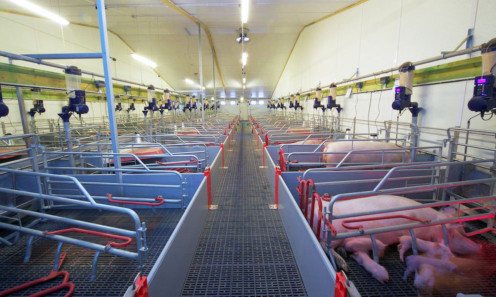A new state-of-the art pig unit near Newton Stewart is now in full production, with the first batches of home-produced high-health hybrid gilts ready for sale.
Dourie Farming Co has taken a long-term view and invested nearly £3 million on a green-field site at Airlour Farm, with the new complex designed to take pig production firmly into the 21st century.
Gregor Christie told a Perth meeting of the Central Scotland Pig Producers Association of his family’s long association with pig farming.
His grandfather had started a unit to run alongside the dairy enterprise in 1954, and over the years this had grown to accommodate 1,100 sows with their progeny taken through to finishing.
“But by the mid- 2000s we could see that the system was far too labour intensive. It was also a highly physical job with a lot of bucket feeding and so on,” he said.
“More importantly, production was poor. Numbers born were fair, but mortality was high.
“Health and Safety was also becoming an issue, especially with dust, and because we had more than 800 sows we came under the strict Integrated Pollution Prevention Control (IPPC) regulations.
“It was clear that if we were to stay in pigs we would have to spend money,” added Gregor, who farms with his father Robin and brother Rory.
“On the other hand it was a priceless apprenticeship. I could see exactly how we could minimise the drudgery,” Gregor said.
The family visited the Pig Fair in 2006 and came away with embryonic ideas for a new 1,000-sow unit.
Study tours to units in the UK, Ireland and the Continent, including France, followed, and plans began to firm up.
There was a blow to come, however, with rejection of an SRDP (Scottish Rural Development Programme) grant application on the grounds that a limited company cannot be a new entrant.
Meanwhile the 2010 surge in feed prices proved the final straw for the old unit, and it was depopulated by November of that year.
A second SRDP rejection followed, and “this led to a change in strategy, with the plan now to run just over 200 sows and complete the project without grant aid using our own resources plus bank borrowing”, said Gregor.
The cost was to be about £10,000 per sow place but, by the time a dedicated feed mill, three 11mW wind turbines and a ring main around the farm for slurry distribution was included, the capital cost came to close to £3m.
By the early design stage in 2012 Gregor was very clear about his requirements.
First of all he wanted an inviting working environment. He decided on a three-week batch farrowing system based on fully slatted housing.
“We have a wet climate in Wigtownshire not suitable for growing our own grain,” he added.
“Transport costs are high, and in any case with 1,500 dairy cows on the farms every acre is needed for grass.
“I also wanted pig welfare to be high on the agenda, as well as automation and on-farm feed manufacturing,” he said.
Most of the buildings and equipment were supplied by pig specialists AM Warkup, with the layout including free access dry sow housing, two 36-crate farrowing houses, three weaner houses and four finishing houses.
Apart from automated feeding at every stage, weigh pads installed between the farrowing houses and the weaner houses enable entire litters to be weighed on the move.
“A similar set up between the weaner and farrowing accommodation allows for batch weighing again, and each of the four finishing houses has an automated weigher and shedding gate to select slaughter pigs as required.
The plans certainly seem to have succeeded as Gregor is now able to run the unit with the help of a 17-year-old assistant.
As to the pigs themselves there is plenty of innovation here, too.
Gregor knew that the Danes were forging ahead by using superior genetics to produce high health breeding stock with very high prolificacy. Reports were coming back of herds regularly producing more than 30 piglets weaned per sow per year.
He pursued the matter and now has a supply arrangement with national research centre Danavl which runs and manages the Danish breeding programme.
The upshot was the delivery in October last year of 230 Danish Landrace gilts.
Large White semen is purchased from Northern Ireland every three weeks, with the aim of producing what is now known as the Dourie UK (DUK) Hybrid.
“Getting the best genetics available is essential. It is a fast-moving world and, remember, the best-performing boar today will not be the best by next week,” Gregor Christie told his audience.
The first home-produced gilts are now at the point of being served and, as well as retaining some for his own use, Gregor is actively marketing breeding stock throughout the UK.
The early signs are certainly promising. Piglets born live from first and second parity sows number 14.3 per litter, with 2.21 litters produced per year.
This represents 31.6 per sow per year, a vast improvement on the 19 pigs produced latterly under the old system at Dourie Farming Co.
Mortality pre-weaning runs at a low 7.9%, and the sow gestation period is 118.5 days.
“We serve on a Tuesday and Wednesday, which means we start farrowing on a Sunday night. It is helpful to take these main tasks away from the weekend,” Gregor added.
Health status remains paramount and is helped by the fact that the nearest commercial pig unit is 50 miles distant.
“The UK pig industry has suffered from underinvestment for many years.
“Our business has made the cash injection and is already seeing the benefits of good, efficient facilities,” concluded Gregor.
